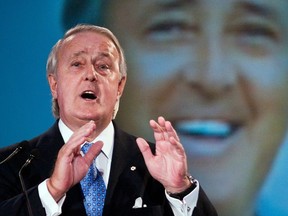A Progressive Conservative in the truest sense, Brian Mulroney’s good works were not recognized at the time, but they will live after him.

Article content
Brian Mulroney left a mixed legacy in Indian Country but overall, he made significant changes that have benefited many First Nations, particularly here in Saskatchewan.
In October 1991, Mulroney was instrumental in reversing the historic animosity toward Louis Riel. Riel had been elected to the House of Commons, but never allowed to take his seat.
Article content
Mulroney introduced a resolution through the House of Commons recognizing Louis Riel as the founder of Manitoba and supporting the constitutional rights of the Red River Métis.
Advertisement 2
Article content
He has also been criticized for his response to the Oka crisis, in particular reacting with the use of the army against Canadian citizens on Canadian soil.
Following the Oka crisis, he announced the formation of the Royal Commission on Aboriginal Peoples. This commission known as RCAP had the mandate to examine the relationship between Indigenous peoples and the Canadian government and to make recommendations on how to improve the lives of Indigenous people across the country.
The final report of the royal commission was released in 1996 with a long list of recommendations that called for improved living conditions in Aboriginal communities, greater recognition of Indigenous rights and title to the land as well as support to self governance.
The report was an enormous tome and the followup was sketchy. Later, the calls to action from the Truth and Reconciliation Commission would repeat many of RCAP’s recommendations. The two commissions laid out the foundation for an improved relationship between Indigenous people and the Canadian government.
Mulroney was a big thinker, not an incrementalist. He campaigned on a free-trade agreement with the United States resulting in increased trade between the two nations. He also stabilized government finances by introducing the controversial GST.
Article content
Advertisement 3
Article content
Since 1976, Saskatchewan First Nations had recognition that many reserves were surveyed much smaller than their population allowed at the time. Both the federal and provincial government agreed, but the solution wasn’t workable.
Both governments placed unoccupied Crown land on the table for selection. This land was usually pastures and land in the boreal forest. In other words, it was land of very little value and even less potential.
Also race relations took a hit because, for many ranchers and farmers, the pastures were a major piece of their operation. Treaty land entitlement was a political minefield, and it couldn’t be ignored and kicked down the road for a future government.
Bill McKnight, a former minister of Indian Affairs and Saskatchewan member of Parliament, raised the issue with Mulroney who agreed that a substantial settlement was in order.
The newly developed Office of the Treaty Commissioner, under the leadership of former Saskatoon mayor Cliff Wright, became the organizing institution. Representatives from the federal and provincial governments and First Nations came together and negotiated the Treaty Land Entitlement Agreement.
Advertisement 4
Article content
In September 1992, Mulroney along with Saskatchewan premier Roy Romanow and FSIN chief Roland Crowe met at Wanuskewin Heritage Park along with the chiefs of 27 First Nations and signed the agreement. Later an additional eight First Nations would complete their research and be eligible for treaty land.
This agreement brought more than $750 million into the provincial economy and transferred about a million acres of land to First Nations. Many older farmers sold their land and were able to retire, land in urban centres was acquired and Indigenous businesses were created.
In 2009, I produced a documentary for the Office of the Treaty Commissioner on the negotiations and history of Treaty Land Entitlement. I needed an interview with Mulroney as a part of the story. We planned to conduct the interview at his office in Montreal.
I was impressed with his generosity and interest in our project. He came out and met our crew on the street and gave generously of his time. He remembered the details of the signing ceremony, including that chief Roland Crowe wore blue jeans, which had the protocol people in a lather.
Advertisement 5
Article content
Brian Mulroney was a Progressive Conservative in the truest sense of the term. The Conservative leaders that followed him were further to the right and lacked his practical experience and humanity. His good works were not recognized at the time, but they will live after him.
Doug Cuthand is the Indigenous affairs columnist for the Saskatoon StarPhoenix and the Regina Leader-Post. He is a member of the Little Pine First Nation.
Recommended from Editorial
Our websites are your destination for up-to-the-minute Saskatchewan news, so make sure to bookmark TheStarPhoenix.com and LeaderPost.com. For Regina Leader-Post newsletters click here; for Saskatoon StarPhoenix newsletters click here.
Article content





